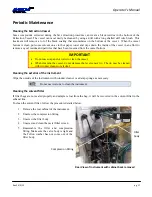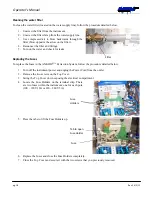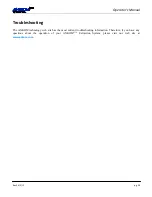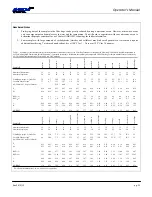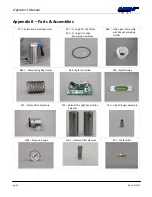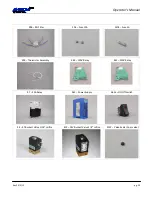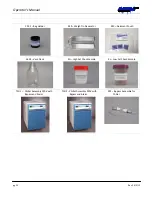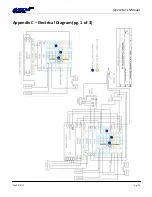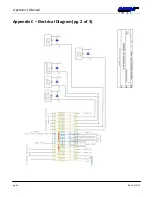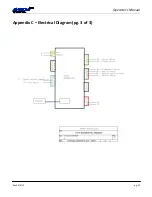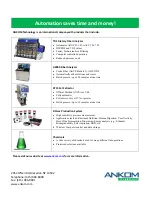
Operator’s
Manual
pg.
20
Rev
E
4/2/12
Appendix
A
–
AOCS
Official
Fat
Extraction
Procedure
ANKOM
Technology
Method
–
Version
1/30/09
AOCS
Official
Procedure
Am
5
‐
04
Rapid
Determination
of
Oil/Fat
Utilizing
High
Temperature
Solvent
Extraction
Definition
This method determines crude fat by extracting with petroleum ether. The compounds extracted are predominantly triacylglycerides. Small
amounts of other lipids along with minor compounds having some solubility in petroleum ether are also extracted.
Scope
This method is applicable to solid processed foods with 0-100% fat content.
Apparatus
1.
Analytical Balance—capable of weighing 0.1 mg.
2.
Oven—capable of maintaining a temperature of 102 ± 2°C
(ANKOM
RD
Dryer, ANKOM Technology).
3.
Extraction instrument—capable of extracting at 90 ± 2°C.
(XT10, XT15, XT20, ANKOM Technology).
4.
Filter Bags—constructed from chemically inert and heat
resistant filter media, capable of being heat sealed closed and
able to retain 1 micron particles while permitting solution
penetration (XT4, ANKOM Technology).
5.
Heat sealer—sufficient for sealing the filter bags closed to
ensure complete closure (1915, ANKOM Technology).
6.
Desiccant Pouch—collapsible sealable pouch with desiccant
inside that enables the removal of air from around the filter bags
(
MoistureStop
weigh pouch, ANKOM Technology).
7.
Marking pen—Solvent and acid resistant (F08, ANKOM
Technology).
Reagents
1.
Petroleum Ether (B.P. 35-65º C). Depending on the method
used, other solvents such as hexanes and ethyl ether may be
used. CAUTION: Most fat solvents are extremely flammable.
Avoid static electricity and follow safe laboratory practices
according to your local regulations when handling solvents.
Precision
Results from the collaborative study (see Table 1) indicate the
precision (S
r
, RSD
r
, r) that the analyst should use as a benchmark for
evaluation replication in the same laboratory.
Procedure
(see
the
Fat
Extraction
Process
section
of
the
Operator’s
Manual
for
more
detail)
1.
Place a labeled filter bag on the balance and zero the balance.
2.
Weigh 1.5 – 2g of sample into the bag and record the weight
(W
1
).
3.
Heat seal the filter bag closed within 4mm of the top to
encapsulate the sample.
4.
It is good practice to include a blank bag periodically,
especially when changing solvents, in order to measure any
effect on the filter bag.
5.
If a meat sample has an expected fat value of > 15% or a plant
sample has an expected fat value of > 20%, then place the
filter bag with sample in a tared weigh tin (W
4
) during the
oven drying procedure in order to capture fat that may migrate
out of the bag during heating.
6.
Place samples in the drying oven for 3 hrs (see Numbered
Note 1).
7.
Cool the dried samples in the Desiccant Pouch, weigh and
record the weight (W
2
).
8.
Place filter bags with sample into the bag holder and place in
the extractor.
9.
Select the extraction time and proceed according to the
extraction instruments instructions.
10.
When the extraction process is complete place the samples in
the oven for 15 – 30 minutes (see Numbered Note 2).
11.
Cool in the Desiccant Pouch and weigh (W
3
).
Calculations
Meat
samples
≤
15%
fat
and
plant
samples
≤
20%
fat
Meat
samples
>
15%
fat
and
plant
samples
>
20%
fat
%
Crude
Fat
=
100
x
(W
2
–
W
3
)
%
Crude
Fat
=
100
x
((W
2
–
W4)
‐
W
3
)
W
1
W
1
Where:
W
1
=
Original
weight
of
sample
Where:
W
4
=
Weight
of
the
weigh
tin
W
2
=
Weight
of
pre
‐
dried
sample
with
filter
bag
W
3
=
Weight
of
dry
sample
with
filter
bag
after
extraction
Содержание XT10
Страница 2: ...This page intentionally left blank ...
Страница 4: ...This page intentionally left blank ...
Страница 25: ...Operator s Manual Rev E 4 2 12 pg 25 Appendix C Electrical Diagram pg 1 of 3 ...
Страница 26: ...Operator s Manual pg 26 Rev E 4 2 12 Appendix C Electrical Diagram pg 2 of 3 ...
Страница 27: ...Operator s Manual Rev E 4 2 12 pg 27 Appendix C Electrical Diagram pg 3 of 3 ...












